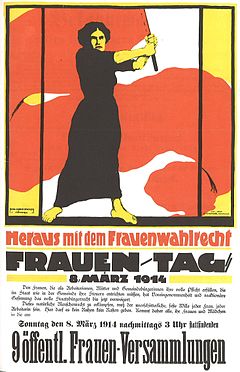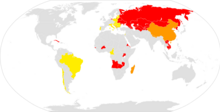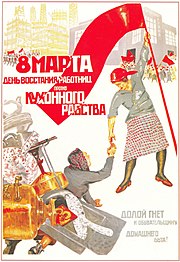| International Women's Day | |
|---|---|

|
|
| Observed by | Worldwide |
| Type | International |
| Significance |
|
| Date | March 8 |
| Next time | March 8, 2019 |
| Frequency | Annual |
| Related to | |
| Part of a series on |
| Feminism |
|---|
March 8 was suggested by the 1910 International Socialist Woman's Conference to become an "International Woman's Day." After women gained suffrage in Soviet Russia in 1917, March 8 became a national holiday there. The day was then predominantly celebrated by the socialist movement and communist countries until it was adopted in 1975 by the United Nations.
Contents
History
Women's demonstration for bread and peace - March the 8th, 1917, Petrograd, Russia
Clara Zetkin and Rosa Luxemburg in January 1910
In August 1910, an International Socialist Women's Conference was organized to precede the general meeting of the Socialist Second International in Copenhagen, Denmark.[10] Inspired in part by the American socialists, German Socialist Luise Zietz proposed the establishment of an annual Women's Day and was seconded by fellow socialist and later communist leader Clara Zetkin, supported by Käte Duncker, although no date was specified at that conference.[11][12] Delegates (100 women from 17 countries) agreed with the idea as a strategy to promote equal rights including suffrage for women.[13] The following year on March 19, 1911, IWD was marked for the first time, by over a million people in Austria, Denmark, Germany and Switzerland.[5] In the Austro-Hungarian Empire alone, there were 300 demonstrations.[11] In Vienna, women paraded on the Ringstrasse and carried banners honouring the martyrs of the Paris Commune.[11] Women demanded that they be given the right to vote and to hold public office. They also protested against employment sex discrimination.[3] The Americans continued to celebrate National Women's Day on the last Sunday in February.[11]
Female members of the Australian Builders Labourers Federation march on International Women's Day 1975 in Sydney
Although there were some women-led strikes, marches, and other protests in the years leading up to 1914, none of them happened on March 8.[14] In 1914 International Women's Day was held on March 8, possibly because that day was a Sunday, and now it is always held on March 8 in all countries.[14] The 1914 observance of the Day in Germany was dedicated to women's right to vote, which German women did not win until 1918.[14][15]
In London there was a march from Bow to Trafalgar Square in support of women's suffrage on March 8, 1914. Sylvia Pankhurst was arrested in front of Charing Cross station on her way to speak in Trafalgar Square.[16]
On March 8, 1917, on the Gregorian calendar, in the capital of the Russian Empire, Petrograd, women textile workers began a demonstration, covering the whole city. This marked the beginning of the Russian Revolution.[17][3] Women in Saint Petersburg went on strike that day for "Bread and Peace" – demanding the end of World War I, an end to Russian food shortages, and the end of czarism.[14] Leon Trotsky wrote, "23 February (8th March) was International Woman's Day and meetings and actions were foreseen. But we did not imagine that this 'Women's Day' would inaugurate the revolution. Revolutionary actions were foreseen but without date. But in the morning, despite the orders to the contrary, textile workers left their work in several factories and sent delegates to ask for support of the strike… which led to mass strike... all went out into the streets."[14] Seven days later, the Emperor of Russia, Nicholas II abdicated and the provisional Government granted women the right to vote.[5]
Following the October Revolution, the Bolshevik Alexandra Kollontai and Vladimir Lenin made it an official holiday in the Soviet Union, but it was a working day until 1965. On May 8, 1965 by the decree of the USSR Presidium of the Supreme Soviet International Women's Day was declared a non-working day in the USSR "in commemoration of the outstanding merits of Soviet women in communistic construction, in the defense of their Fatherland during the Great Patriotic War, in their heroism and selflessness at the front and in the rear, and also marking the great contribution of women to strengthening friendship between peoples, and the struggle for peace. But still, women's day must be celebrated as are other holidays."
From its official adoption in Soviet Russia following the Revolution in 1917, the holiday was predominantly celebrated in communist countries and by the communist movement worldwide. It was celebrated by the communists in China from 1922.[11] After the founding of the People's Republic of China on October 1, 1949 the State Council proclaimed on December 23 that March 8 would be made an official holiday with women in China given a half-day off.[18]
Communist leader Dolores Ibárruri led a women's march in Madrid in 1936 on the eve of the Spanish Civil War.[11]
The United Nations began celebrating International Women's Day in the International Women's Year, 1975. In 1977, the United Nations General Assembly invited member states to proclaim March 8 as the UN Day for women's rights and world peace.[19]
IWD 2010
A U.S. servicemember dressed in a traditional Afghan dress during a celebration of International Women's Day in Bagram Air Base, Afghanistan
IWD 2011
Events took place in more than 100 countries[21] on March 8, 2011 to commemorate the 100th anniversary of International Women's Day.[22] In the United States, President Barack Obama proclaimed March 2011 to be "Women's History Month", calling Americans to mark IWD by reflecting on "the extraordinary accomplishments of women" in shaping the country's history.[21] Secretary of State Hillary Clinton launched the "100 Women Initiative: Empowering Women and Girls through International Exchanges", on the eve of IWD.[23] In the run-up to 2011 International Women's Day, the Red Cross called on States and other entities not to relent in their efforts to prevent rape and other forms of sexual violence that harm the lives and dignity of countless women in conflict zones around the world every year.[24] In Pakistan, the Punjab Government Project Gender Reform Action Plan (GRAP), Gujranwala District celebrated this day at the GIFT University Gujranwala. Shazia Ashfaq Mattu, MPA and GRAP officer Yasir Nawaz Manj organized the events.[citation needed]Australia issued an IWD 100th anniversary commemorative 20-cent coin.
In Egypt, however, the day was a step back for women. In Egypt's Tahrir Square, hundreds of men came out not in support, but to harass the women who came out to stand up for their rights as the police and military stood by watching the events unfold in front of them, doing nothing to stop the crowds of men. "The women – some in headscarves and flowing robes, others in jeans – had marched to Cairo's central Tahrir Square to celebrate International Women's Day. But crowds of men soon outnumbered them and chased them out", wrote Hadeel Al-Shalchi for The Associated Press (AP).[25]
IWD 2012
The UN theme for International Women's Day 2012 was Empower Rural Women – End Hunger and Poverty.[26] In that year, Oxfam America invited people to celebrate inspiring women in their lives by sending a free International Women's Day e-Card or honoring a woman whose efforts had made a difference in the fight against hunger and poverty with Oxfam's International Women's Day award.[27]On the occasion of International Women's Day 2012, the ICRC called for more action to help the mothers and wives of people who have gone missing during armed conflict. The vast majority of people who go missing in connection with conflict are men. As well as the anguish of not knowing what has happened to the missing husband or son, many of these women face economic and practical difficulties. The ICRC underlined the duty of parties to a conflict to search for the missing and provide information to the families.[28]
IWD 2013
The UN theme for International Women's Day 2013 was "A promise is a promise: Time for action to end violence against women",[29] while International Women's Day 2013 declared the year's theme as The Gender Agenda: Gaining Momentum.[30]The 2013 International Women's Day, the International Committee of the Red Cross (ICRC) draw attention to the plight of women in prison.[31]
IWD 2014
The UN theme for International Women's Day 2014 is "Equality for Women is Progress for All".[32][33]American singer Beyoncé also posted an International Women's Day video to her YouTube account. Throughout the video, her song "***Flawless" plays, which includes a portion of the "We Should All Be Feminists" speech given by author Chimamanda Ngozi Adichie. Beyoncé is a feminist.[34]
IWD 2015
Women on the street celebrating International Women's Day in Cameroon
IWD 2016
The International Women's Day theme for 2016 was "Planet 50-50 by 2030: Step It Up for Gender Equality".[37]The President of India, Shri Pranab Mukherjee, in his message issued on the eve of International Women's Day said: "On the occasion of International Womens Day, I extend warm greetings and good wishes to the women of India and thank them for their contributions over the years in the building of our nation."[38] The ministry of women and child development announced the setting up of four more one-stop crisis centers on March 8, in addition to the eight already functioning across the country.[39] Ahead of Women's Day, the national carrier Air India operated what it claimed to be the world's longest non-stop flight where the entire flight operations were handled by women, as part of International Women's Day celebrations. The flight, from Delhi to San Francisco, covered a distance of around 14,500 kilometers in around 17 hours.[40]
IWD 2017
The theme for International Women's Day 2017 was "Women in the Changing World of Work: Planet 50-50 by 2030".[41]In a message in support of International Women's Day, the UN Secretary-General António Guterres commented on how women's rights were being "reduced, restricted and reversed". With men still in leadership positions and a widening economic gender gap, he called for change "by empowering women at all levels, enabling their voices to be heard and giving them control over their own lives and over the future of our world".[42]
IWD 2018
The theme for International Women's Day 2018 was chosen as - 'Time is Now: Rural and urban activists transforming women’s lives'.[43]Around the world
Official holiday
Holiday for women
Non-official holiday
In some countries, such as Cameroon,[63] Croatia,[64] Romania,[65] Bosnia and Herzegovina,[66] Bulgaria[67] and Chile,[68] the day is not a public holiday, but is widely observed nonetheless. On this day it is customary for men to give the women in their lives – friends, mothers, wives, girlfriends, daughters, colleagues, etc. – flowers and small gifts. In some countries (such as Bulgaria and Romania) it is also observed as an equivalent of Mother's Day, where children also give small presents to their mothers and grandmothers.[65]
1932 Soviet women's day poster emphasizing the freeing of women from their second-class-citizen status.[b]
International Women's Day sparked violence in Tehran, Iran on March 4, 2007, when police beat hundreds of men and women who were planning a rally. (A previous rally for the occasion was held in Tehran in 2003.)[70] Police arrested dozens of women and some were released after several days of solitary confinement and interrogation.[71] Shadi Sadr, Mahbubeh Abbasgholizadeh and several more community activists were released on March 19, 2007, ending a fifteen-day hunger strike.[72]
Yellow mimosa is the symbol of IWD in Italy
In the United States, actress and human rights activist Beata Pozniak worked with the Mayor of Los Angeles and the Governor of California to lobby members of the U.S. Congress to propose official recognition of the holiday. In February 1994, H. J. Res. 316 was introduced by Rep. Maxine Waters, along with 79 cosponsors, in an attempt to officially recognize March 8 of that year as International Women's Day. The bill was subsequently referred to, and remained in, the House Committee on Post Office and Civil Service. No vote of either house of Congress was achieved on this piece of legislation.[76]
Official UN themes
| Year | UN Theme[77] |
|---|---|
| 1996 | Celebrating the Past, Planning for the Future |
| 1997 | Women and the Peace Table |
| 1998 | Women and Human Rights |
| 1999 | World Free of Violence Against Women |
| 2000 | Women Uniting for Peace |
| 2001 | Women and Peace: Women Managing Conflicts |
| 2002 | Afghan Women Today: Realities and Opportunities |
| 2003 | Gender Equality and the Millennium Development Goals |
| 2004 | Women and HIV/AIDS |
| 2005 | Gender Equality Beyond 2005; Building a More Secure Future |
| 2006 | Women in Decision-making |
| 2007 | Ending Impunity for Violence Against Women and Girls |
| 2008 | Investing in Women and Girls |
| 2009 | Women and Men United to End Violence Against Women and Girls |
| 2010 | Equal Rights, Equal Opportunities: Progress for All |
| 2011 | Equal Access to Education, Training, and Science and Technology: Pathway to Decent Work for Women |
| 2012 | Empower Rural Women, End Poverty and Hunger |
| 2013 | A Promise is a Promise: Time for Action to End Violence Against Women |
| 2014 | Equality for Women is Progress for All |
| 2015 | Empowering Women, Empowering Humanity: Picture it! |
| 2016 | Planet 50-50 by 2030: Step It Up for Gender Equality |
| 2017 | Women in the Changing World of Work: Planet 50-50 by 2030 |
| 2018 | Time is Now: Rural and urban activists transforming women’s lives |
See also
- Communist Women's International
- Day Without a Woman
- International Day for the Elimination of Violence against Women
- International Day of the Girl Child
- International Men's Day
- List of uprisings led by women
- Identity Politics
- UN Women
Other holidays honoring women
- Susan B. Anthony Day (February 15)
- Rosa Parks Day (February 4 / December 1)
- National Girls and Women in Sports Day (one day first week of February)
- Harriet Tubman Day (March 10)
- Kartini Day (April 21 in Indonesia)
- Helen Keller Day (June 27)
- Women's Equality Day (August 26)
- Mother's Day







